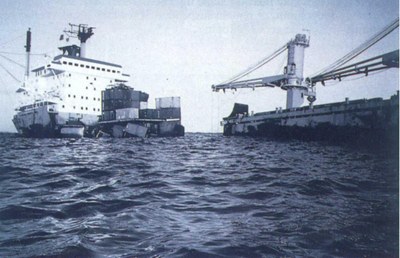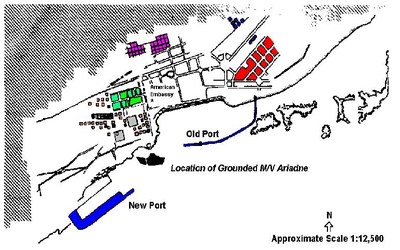1985 - Ariadne
| Year | 1985 |
| Vessel | Ariadne |
| Location | Mogadishu, Somalia |
| Cargo type | Package |
| Chemicals | ACETONE , DIPENTENE , ETHYL ACETATE , ISOBUTANOL , ISOPROPANOL , METHYL ETHYL KETONE , METHYL FORMATE , n-BUTYL ACETATE , SODIUM PENTACHLOROPHENATE , TETRAETHYL LEAD , TOLUENE , TRICHLOROETHYLENE , XYLENES meta |
Summary
On August 22, 1985 the Panamanian registered vessel "Ariadne" entered Mogadishu harbour, Somalia to offload cargo at port facilities. On August 24, while departing from the harbour, the container ship M/V "Ariadne" grounded on rocks approximately 100 metres from shore (Figure 1). The ship carried in its holds and as deck cargo 118 containers of hazardous cargo, as well as 482 containers of general cargo. It also carried 160 metric tons of diesel oil and 645 metric tons of heavy fuel oil. As the list on the ship increased, 14 containers and several vehicles fell overboard. A contract for salvage operations was signed on August 27 with a company based in Mombasa, Kenya. Salvage efforts began on September 1 using 2 salvage tugs and hydraulic pumps. The company was unable to refloat the vessel and lost all the available salvage pumps when the engine room flooded. As a result, attempts to refloat the ship were discontinued but attempts to unload deck cargo from the ship commenced on September 14 and 15. On September 26, the deck at hatch No. 5 collapsed and a fire of short duration broke out over hold No. 4. On September 27, the vessel broke in two (Figure 2) and large quantities of oil and cargo, including drums containing chemicals, began to wash ashore. At the request of the Somali Government, five countries sent advisory teams to the site specialized in salvage, fire fighting, spill response, chemistry and environmental assessment, which arrived on September 28. By September 29, 113 containers were removed whilst heavy oil and cargo from hold No. 5 continued to wash ashore. On September 30, the stern section separated further and assumed a 90 degree list whilst plans to refloat the bow section with locally available equipment and tow it alongside the dock were abandoned.
Narrative
On August 22, 1985 the Panamanian registered vessel "Ariadne" entered Mogadishu harbour, Somalia to offload cargo at port facilities. On August 24, while departing from the harbour, the container ship M/V "Ariadne" grounded on rocks approximately 100 metres from shore (Figure 1). The ship carried in its holds and as deck cargo 118 containers of hazardous cargo, as well as 482 containers of general cargo. It also carried 160 metric tons of diesel oil and 645 metric tons of heavy fuel oil. As the list on the ship increased, 14 containers and several vehicles fell overboard. A contract for salvage operations was signed on August 27 with a company based in Mombasa, Kenya. Salvage efforts began on September 1 using 2 salvage tugs and hydraulic pumps. The company was unable to refloat the vessel and lost all the available salvage pumps when the engine room flooded. As a result, attempts to refloat the ship were discontinued but attempts to unload deck cargo from the ship commenced on September 14 and 15. On September 26, the deck at hatch No. 5 collapsed and a fire of short duration broke out over hold No. 4. On September 27, the vessel broke in two (Figure 2) and large quantities of oil and cargo, including drums containing chemicals, began to wash ashore. At the request of the Somali Government, five countries sent advisory teams to the site specialized in salvage, fire fighting, spill response, chemistry and environmental assessment, which arrived on September 28. By September 29, 113 containers were removed whilst heavy oil and cargo from hold No. 5 continued to wash ashore. On September 30, the stern section separated further and assumed a 90 degree list whilst plans to refloat the bow section with locally available equipment and tow it alongside the dock were abandoned.
Resume
1. Need for additional salvage equipment and expertise; it was evident that the initial salvage company contracted to carry out operations did not have the necessary heavy salvage equipment to remove the wreck or all its cargo. The wreck was removed by a salvage tug and a large floating crane brought to Mogadishu from Europe. For this, a governmental delegation was dispatched to London, U.K. to expedite the negotiations with the second salvage company.
2. Danger of toxic fumes from further fires and explosions aboard the ship; the fire of September 26 produced smoke and chemical fumes that drifted towards the city. Limited evacuation of residences and businesses along the harbour area had been ordered by local authorities and remained in force for sometime. A concern was preventing further fires or explosions and protecting the population should these arise. Advice was given to use extreme care in the offloading operations to avoid igniting any potentially explosive vapours. Opinions differed among the international technical advisors as to the need of further evacuation should another fire occur.
3. Presence and possible release of tetraethyl lead; the vessel carried 118 metric tons of tetraethyl lead in drums which were stowed in seven containers at the bottom of No. 5 hold. Since the break-up of the ship occurred at No. 5 hold, there was concern about the release of this toxic substance into the water. A high priority was placed on locating and recovering the drums of tetraethyl lead which was still intact. Since the necessary equipment and expertise were not available to salvage the drums, the work could only be carried out by the second salvage company.
4. Possible port blockage by the wreck; blockage of the port entrance was a concern if the wreck moved seaward from its original grounding position. A proposal to refloat the partially buoyant bow section using locally available equipment and move it to the dock area was first considered. Due to concern and fear that potentially explosive vapours trapped in holds No.1, 2 and 3 could be ignited by sparks from electric pumps, it was decided to wait to clear the wreck until the second salvage company arrived on the scene with the proper equipment and expertise.
5. Recovery of chemical drums and other containers from the beach and water surrounding the wreck; under supervision of the police, local people in small boats and on the beach began to recover the drums. All recovered materials were loaded onto trucks and transported to the port area for storage. Despite concern over the lack of protective clothing, recovery operations of the drums continued. Attempts to plug leaking drums without protective clothing also took place. Efforts were made to segregate material, provide shade for drums and to absorb leaking chemicals with sand. In the storage area, no effort was made to curtail smoking nor was the area tightly controlled. Furthermore, men on duty at this storage area also experienced dizziness, headaches and nausea.



